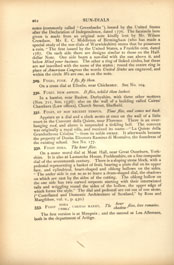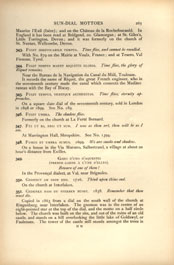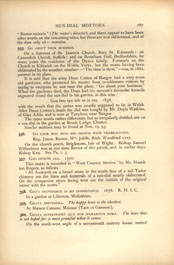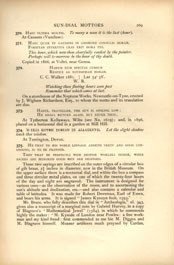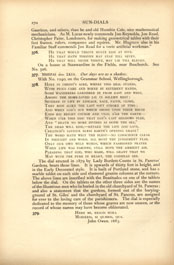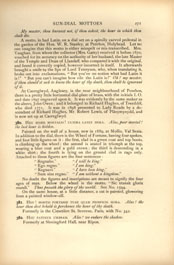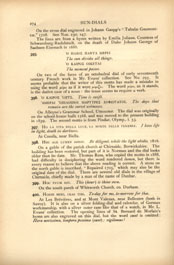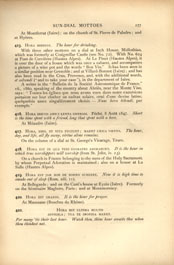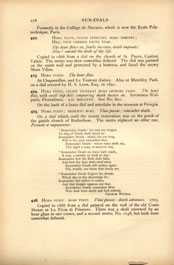Sun-Dial Mottoes (continued.)

[Full Image]
UNITED STATES NATIONAL NOTE.
the front of Blackhills house in Castlegate is a stone, having the appearance of armorial bearings. Having examined it, I found two rather peculiar sun-dials with an inscription on an iron scroll, Fuerat cuncta novanthus." No suggestion is made as to the meaning of the words. |
|
| 324. | FUGACEM DIRIGIT UMBRAM. He guides the fleeting shadow. On the church of St. Sulpice, Paris. |
| 325. | FUGAX EST ÆTAS. Time is fleeting. On a church, Westbury on Severn. |
| 326. |
FUGGONE COME L'OMBRA E DÌ DELL' ANNO; Given in "Notizie Gnomoniche." |
| 327. | FUGGONE I GIORNI TUOI QUAL OMBRA, O VENTO, Given in "Notizie Gnomoniche." |
| 328. | FUGIO. I fly. MIND YOUR BUSINESS. On a woodcut of a sun-dial which was on the first set of National- |
| notes (commonly called "Greenbacks"), issued by the United States after the Declaration of Independence, dated 1776. The facsimile here given is made from an original note kindly lent by Mr. Wilson Crewdson. Mr. E. C. Middleton of Birmingham (who has made a special study of the sun-dials of Warwickshire) states that he possesses a coin, "The first issued by the United States, a Franklin cent, dated 1787. On each side there are designs similar to those on the Half-dollar Note. One side bears a sun-dial with the sun above it, and below Mind your business. The other a ring of linked circles, but these are not inscribed with the name of the states; round the centre ring in place of American Congress the words United States are engraved, and within the circle We are one, as on the note. | |||||||
| 329. | FUGIO, FUGE. I fly, fly thou. On a cross dial at Elleslie, near Chichester. See No. 104. |
||||||
| 330. | FUGIT, DUM ASPICIS. It flies, whilst thou lookest. In a hamlet, near Baslow, Derbyshire, with three other mottoes (Nos. 711, 800, 1536); also on the wall of a building called Cairns' Chambers (Law offices), Church Street, Sheffield. |
||||||
| 331. | FUGIT, ET NON RECEDIT TEMPUS. Time flies, and comes not back. Appears as a dial and a clock motto at once on the wall of a little court in the Convent della Quiete, near Florence. There is an overhanging roof, and above is suspended a tinkling bell. The convent was originally a royal villa, and received its name – "La Quiete della Granduchessa Cristina" – from its noble owner. It afterwards became the property of Donna Eleonora Ramirez di Montalvo, the foundress of the existing school. See No. 177. |
||||||
| 332. | FUGIT HORA. The hour flies. On a stone mural dial at Moat Hall, near Great Ouseburn, Yorkshire. It is also at Lamancha House, Peeblesshire, on a fine composite dial of the seventeenth century. There is a sloping stone block, with a pedestal representing a basket of fruit, bearing a plain dial on its upper face, and cylindrical, heart-shaped and oblong hollows on the sides. "The under side is cut so as to leave a drum-shaped dial, the shadows on which are cast by the sides of the cutting. The oblong hollow on the one side has two carved serpents starting with their intertwisted tails and wriggling round the sides of the hollow, the upper edge of which forms the style." The dial and pedestal are cut out of one stone. ("Castellated and Domestic Architecture of Scotland", by Ross and Macgibbon, vol. v., p. 430.) |
||||||
| 333. |
The first version is at Mirepoix; and the second at Les Allemans, both in the department of Ariège. |
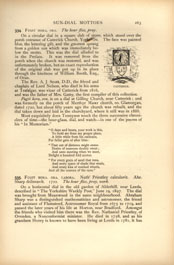
[Full Image]
CATTERICK.
| 334. | FUGIT HORA, ORA. The hour flies, pray. On a circular dial in a square slab of stone, which stood over the porch entrance of Catterick Church, Yorkshire. The face was painted blue, the lettering gilt, and the gnomon sprang from a golden sun which was immediately below the motto. This was the dial alluded to in the Preface. It was removed from the porch when the church was restored, and was unfortunately broken, but an exact reproduction of the original slab was put up in its place through the kindness of William Booth, Esq., of Oran. The Rev. A. J. Scott, D. D., the friend and chaplain of Lord Nelson, who died in his arms at Trafalgar, was vicar of Catterick from 1816, and was the father of Mrs. Gatty, the first compiler of this collection. Fugit hora, ora is on a dial at Gilling Church, near Catterrick; and was formerly on the porch of Merthyr Mawr church, co. Glamorgan, dated 1720, but about fifty years ago the church was rebuilt, and the dial taken down and laid in the churchyard, where it still was in 1888. Most exquisitely does Tennyson touch the three successive chroniclers of time – the hour-glass, dial, and watch – in one of the poems of his "In Memoriam."
|
| 335. | FUGIT HORA. ORA. LABORA. Nathl Priestly calculavit. Abr. Sharp delineavit. 1722. The hour flies, pray, work. On a horizontal dial in the old garden of Alderhill, near Leeds, described in "The Yorkshire Weekly Post," June 19, 1897. The dial was brought from Meanwood in the same neighbourhood. Abraham Sharp was a distinguished mathematician and astronomer, the friend and assistant of Flamsteed, Astronomer Royal from 1675 to 1719, and passed the later years of his life at Horton, near Bradford. Amongst the friends who visited him there was the Rev. Nathaniel Priestley, of Ovenden, a Nonconformist minister. He died in 1728, and as his grandson Henry is known to have been living at Leeds in 1781, it has |
been conjectured that the dial may have been brought by him to Meanwood. The dial plate is finely worked, and is placed on a stone pedestal. The same motto was read some years ago on a house in Southgate Street, Gloucester, but the dial is no longer there. |
|
| 336. | FUGIT HORA SIC EST VITA. The hour flies, so with life. This is given as the probable reading of a dial on the church tower of Cubberley, Gloucestershire. The motto seemed to be Fugit hora suevet, and has, says a writer in "Notes and Queries," proved a very sphinx to inquirers. The solution is suggested by a correspondent in "Notes and Queries," 4th series, x. 254, 323. |
| 337. | FUGIT HORA SICUT UMBRA. The hour flies like a shadow. This motto is written on an illustration in a French MS. on dials in the possession of Lewis Evans, Esq. The MS. appears to have been written at Nancy in the first half of the eighteenth century. |
| 338. | FUGIT HORA SINE MORA. The hour flies without delay. Seen at North Wingfield, Derbyshire. |
| 339. | FUGIT (HORA) UTERE. The hour flies, use it. In the court of the Lycée at Limoges; and on the façade of the Petit Séminaire, Dorat, France. |
| 340. | FUGIT HORA, VENIT HORA. The hour flies, the hour draws nigh. On a horizontal slate dial in the kitchen garden at the Château de Vaux (Calvados), the residence of M. Caumont, founder of the Société Française d'Archéologie. The dial was brought from the Abbey of St. Barbe-en-Ange. In the centre there is a shield of arms surmounted by a count's coronet. |
| 341. | FUGIT IRREPARABILE. 1829. Time flies, and cannot be retrieved. On the Caserne de l'Oratoire, Grenoble. |
| 342. | FUGIT IRREPARABILE TEMPUS. Time passes never to be retrieved. Sedente Gregorio XVI. p.o.m. Antonius Mattevcius Oper. Vatican. prepositus. Ioanni Antonio Teppati hocce horarium lineari mandavit. Anno Dni. MDCCCXLIII. This sentence records that the dial was made and erected in the pontificate of Gregory XVI., A.D. 1843, by Giovanni Antonio Teppati. It is on the south corner of the balustrade on the roof of St. Peter's, Rome; the dial being engraved on a horizontal slab of white marble. The words of the motto are from Virgil (see No. 1123). They were also formerly to be seen with No. 380 in the Cimetière St. Severne, Paris; and were copied in 1860 from a circular vertical dial placed below the gable and bell-cot of the church at Vallauris, near Cannes, and dated 1839. The same motto has been noticed at Guitalan (Tarn); St. |
| Maurice l'Exil (Isère); and on the Château de la Rochefoucauld. In England it has been read at Bridgend, co. Glamorgan; at St. Giles's, Little Torrington, Devon; and it was formerly on the church of St. Nectan, Wellcombe, Devon. | |
| 343. | FUGIT IRREVOCABILE TEMPUS. Time flies, and cannot be recalled. With No. 879 on the Mairie at Voulx, France; and at Tesero, Val Fiemme, Tyrol. |
| 344. | FUGIT TEMPUS MANET RIQUETTI GLORIA. Time flies, the glory of Riquet remains. Near the Bureau de la Navigation du Canal du Midi, Toulouse. It records the name of Riquet, the great French engineer, who in the seventeenth century made the canal which connects the Mediterranean with the Bay of Biscay. |
| 345. | FUGIT TEMPUS, VENITQUE AETERNITAS. Time flies, eternity approaches. On a square dial of the seventeenth century, sold in London in 1898 or 1899. See No. 189. |
| 346. | FUGIT UMBRA. The shadow flies. Formerly on the church at La Ferté Bernard. |
| 347. | FUI UT ES, ERIS UT SUM. I was as thou art, thou wilt be as I am. At Marrington Hall, Shropshire. See No. 1394. |
| 348. | FUMUS ET UMBRA SUMUS. 1699. We are smoke and shadow. On a house in the Via Maestro, Salbertrand, a village at about an hour's distance from Exilles. |
| 349. |
GARO D'UNO D'AQUESTEI In the Provençal dialect, at Val, near Brignoles. |
| 350. | GEDENCT AM DEIN END. 1726. Think upon thine end. On the church at Interlaken. |
| 351. | GEDENKE DASS DU STERBEN MUSST. 1838. Remember that thou must die. Copied in 1863 from a dial on the south wall of the church at Ringenburg, near Interlaken. The gnomon was in the centre of an eight-pointed star at the top of the dial, and the motto on a half circle below. The church was built on the site, and out of the ruins of an old castle, and stands on a hill overlooking the little lake of Goldswyl, or Faulensee. The tower of the castle still stands amongst the trees in |
| the churchyard. The church was transferred to this place from Goldswyl in 1674. | |
| 352. | GIVE GOD THY HEART, THY HOPES, THY SERVICE AND THY GOLD, THE DAY WEARS ON, AND TIME IS WAXING OLD. On a pedestal dial in the garden of St. Lucy's Home, Gloucester. The dial rest upon a metal plate, and on this the above lines are engraved. The pedestal is a wooden baluster which was taken from old London Bridge when it was pulled down in 1832. The Warden of the Home, who in 1888 owned the dial, could recollect it for sixty years, and before it was placed on its present pedestal. The late Rev. F. E. Paget introduced a motto greatly resembling the above into one of his "Tales of the Village," The Miser's Heir, as follows: "As I proceeded leisurely round Baggesden Hall, I observed an ancient sun-dial, adorned with heraldic devices, and grotesque emblems of mortality, carved in stone, according to the style which prevailed at the close of the sixteenth century. On a scroll above it was inscribed, 'Homfrie and Elianor Bagges. A.D. 1598'; and beneath it, in smaller but still legible characters, the following rhyme: "'Give God thy heart, thy hopes, thy gifts, thy gold, The description is altogether imaginary, and Mr. Paget had no recollection in later years of ever having seen the lines, but there can be little doubt that they had come originally from St. Lucy's Home. |
| 353. |
GIVE LIGHT TO THEM THAT SIT IN DARKNESS, At Broughton Castle, near Banbury, there is a garden dial, the gnomon of which is of clipped box, and the hour numerals are of flowers and foliage cut close, and set in a semi-circular bed surrounded by green turf. The above motto surrounds the numerals, and is also written in flowers and foliage. See "Country Life," December 17th, 1898. |
| 354. |
ΓΝΩΘΙ ΚΑΙΡΟΝ.
These four mottoes, which seem intended to be read consecutively, are on four sides of the cubical top of a column about four feet high which supports a horizontal dial in the rectory garden at Micheldean, Gloucestershire. The shaft is ornamented with a Tudor rose and diamond in relief. On the two sides of the plinth are the words |
| "Rector rectoris" (The rector's director), and there appear to have been other words on the remaining sides, but these are now obliterated, and of the date only 16– remains. | |
| 355. | GO ABOUT YOUR BUSINESS. On a buttress of St. James's Church, Bury St. Edmunds; on Cavendish Church, Suffolk; and on Bromham Hall, Bedfordshire, for many years the residence of the Dynes family. Formerly on the Church at Kilnwick on the Wolds, Yorks., but the motto having been obliterated by the weather, another – "The time is short" – was, in 1882, painted in its place. It is said that the witty Dean Cotton of Bangor had a very cross old gardener, who protected his master from troublesome visitors by saying to everyone he saw near the place, "Go about your business." When the gardener died, the Dean had his servant's favourite formula engraved round the sun-dial in his garden, in this wise: Goa bou tyo urb us in ess. 1838. with the result that the motto was usually supposed to be in Welsh. After Dean Cotton's death the dial was bought by Mr. Doyle Watkins, of Glan Adda, and is now at Tanyfrou, near Bangor. The same words rather differently, but as irregularly divided, are on a sun-dial in the garden at Brook Lodge, Chester. |
| 356. |
GO YOUR WAY INTO HIS COURTS WITH THANKSGIVING. On the church porch, Brighstone, Isle of Wight. Bishop Samuel Wilberforce was at one time Rector of this parish, and, in earlier days, Bishop Ken. See Ps. c. 3. |
| 357. | GOD GIVETH ALL. 1570. This motto is recorded in "West Country Stories," by Mr. Hamilton Rogers, as follows: "At Axmouth on a broad stone in the south face of a tall Tudor chimney are the lines and numerals of a sun-dial nearly obliterated. On the companion stone facing west are the initials of the original owner with the motto." |
| 358. | GOD'S PROVIDENCE IS MY INHERITANCE. 1676. R. H. I. C. In a garden at Liberton, Midlothian. |
| 359. | GRATA BREVISSIMA. The happy hour is the shortest. At Maison Catusse, Moissac (Tarn et Garonne). |
| 360. | GRATA SUPERVENIET QUÆ NON SPERABITUR HORA. The hour that is not hoped for is most grateful when it comes. On the south-west angle of a seventeenth century house, named |
| Denburn, at Crail, Fifeshire. The line is from Horace, Ep. i. 4, 14. The preceding line "Omnem crede diem tibi diluxisse supremam" (Think every dawn of day to be thy last) is used as a motto on another dial on the same house, though it is now almost illegible. | |
| 361. | GRATIA DEI MECUM. The grace of God with me. One of the mottoes on the dial pillar at Corpus Christi College, Oxford. See No. 280. |
| 362. | GUARDANDO IL MEZZODÌ, PENSATI ALLA SERA. When mid-days's hour thou seest, of eventide bethink thyself. Read in a garden in Tuscany. |
| 363. | G UARDANDO L'ORE, PENSA CHE SI MUORE. Gazing on the hour, think! death comes to all. Given in "Notizie Gnomoniche." |
| 364. | GWEL DDYN MEWN GWIWLAN DDEUNYDD Behold, O man, the day it fleeth without tarrying. At Whitford Church, Flintshire. |
| 365. | HAEC CUM SOLE FUGAX THEMIDIS MARTISQUE LABORES This shadow, fleeting with the sun, controls the toils of law-court, camp, and market-place. With other mottoes in the Place d'Armes, Briançon. See No. 8. |
| 366. | HAEC MEA FORTUNA TUA. This my fate is thine. Formerly at St. Lazaire, Paris. |
| 367. |
HAEC MONET UT CELERI FUGIT IMPETU TEMPUS IMAGO. In the garden of the Presbytère at Plaudren (Morbihan). |
| 368. | HAEC PATET ET TUA LATET, What hour' tis now, is plain, – thy hour is hid: At Les Tombêtes, Savoy. |
| 369. | HAEC VLTIMA FORSAN. Perchance this is thy last (hour). At Malemort (Bouches du Rhône) |
| 370. | HAEC VLTIMA MULTIS. To many a man it is the last (hour). At Causans (Vaucluse). |
| 371. |
Copied in 1866, at Voltri, near Genoa. |
| 372. |
HARUM DUM SPECTAS CURSUM
Watching these fleeting hours soon past On a storehouse of the Neptune Works, Newcastle-on-Tyne, erected by J. Wigham Richardson, Esq., to whom the motto and its translation are due. |
| 373. | HASTE, TRAVELLER, THE SUN IS SINKING LOW: At Tytherton Kellaways, Wilts (see No. 1619); and, in 1869, placed on a horizontal dial in the garden at Mill Hill. |
| 374. |
῾Η
ΣΚΙΑ
ΚΟϒΦΗ ΣΟΦΙΑΝ ΣΕ
ΔΙΔΑΣΚΕΤΩ.
At Torrington, Devon. |
| 375. | HE THAT TO HIS NOBLE LINNAGE ADDETH VERTV AND GOOD CONDISIONS, IS TO PRAYSED. THEY THAT BE PERFECTLI WISE DESPISE WORLDLI HONOR, WHER RICHES ARE HONORED GOOD MEN ARE DESPISED. These two sayings are inscribed on the outer edges of a circular box of gilt brass, 2 1/4 inches in diameter, now in the British Museum. On the upper surface there is a nocturnal dial, and within the box a compass and three circular metal plates, on one of which the twenty-four hours of the day and night are engraved. The instrument is designed for various uses – as the observation of the moon, and to ascertaining the sun's altitude and declination, etc. – and also contains a calendar and table of latitudes. It was made for Robert Devereux, Earl of Essex, and bears his arms. It is signed "James Kynuyn fecit, 1593." Mr. Bruce, who fully describes this dial in "Archeologia," xl. 343, gives also a transcript of a marginal note by Gabriel Harvey, in a copy of Blagrave's "Mathematical Jewel" (1584), in which he commends highly the maker: M. Kynuin of London near Powles: a fine workman and my kind frend: first commended to me bie M. Digges and M. Blagrave himself. Meaner artificers much praysed by Cardan, |
| Gauricus, and others, than he and old Humfrie Cole, nice mathematical mechanicians. As M. Lucas newly commends Jon Reynolds, Jon Read, Christopher Paine, Londoners, for making geometrical tables with their feet frames, rulers, compasses and squires. Mr. Blagrave also in his Familiar Staff commends Jon Read for a verie artificial workman." | |
| 376. |
HE THAT WOULD THRIVE MUSTE RISE AT FIVE. On a house at Stanwardine in the Fields, near Baschurch. See No. 506. |
| 377. | ῾ΗΜΕΡΑΙ ὡσει ΣΚΙΑ. Our days are as a shadow. With No. 1040, on the Grammer School, Wellingborough. |
| 378. |
HERE IN CHRIST'S ACRE, WHERE THIS DIAL STANDS, The dial erected in 1879 by Lady Burdett-Coutts in St. Pancras' Gardens, bears these lines. It is upwards of thirty feet in height, and in the Early Decorated style. It is built of Portland stone, and has a marble tablet on each side and clustered granite columns at the corners. The above lines are inscribed with the Beatitudes on one of the tablets below the dial. On the tablets on the other three sides are the names of the illustrious men who lie buried in the old churchyard of St. Pancras; and also a statement that the gardens, formed out of the burying-ground of St. Giles' and the churchyard of St. Pancras, are assigned for ever to the loving care of the parishioners. The dial is especially dedicated to the memory of those whose graves are now unseen, or the record of whose names may have become obliterated. |
| 379. | HERE MI, NESCIS HORA |
My master, thou knowest not, if thou askest, the hour in which thou shalt die. A motto, in bad Latin, on a dial set on a spirally carved pedestal in the garden of the Hon. W. R. Stanley, at Penrhos, Holyhead. Let no one imagine that this motto is either misspelt or mis-transcribed. Mrs. Vaughan, from whom the collector (Mrs. Gatty) received it before 1870, vouched for its accuracy on the authority of her husband, the late Master of the Temple and Dean of Llandaff, who compared it with the original, and found it correctly copied, however incorrect in itself. It afterwards brought a smile to the lips of Lord Tennyson, who, when translating it, broke out into exclamations, "But you've no notion what bad Latin it is!" "But you can't imagine how vile the Latin is!" Oh! my master, if thou should'st seek to know the hour of thy death, thou shalt be ignorant of it. At Caereglwyd, Anglesey, in the near neighbourhood of Penrhos, there is a pretty little horizontal dial-plate of brass, with the initials I. O. and date 1697 engraved upon it. It was evidently by the same maker as the above, John Owen; and it belonged to Richard Hughes, of Treeddôl, who died 1771. It was in 1898 presented to Lady Reade by a descendant of Richard Hughes, Mr. Robert Lewis, of Plâsymynydd, and is now set up at Caereglwyd. |
|||||||||
| 380. | HEU MISER MORTALIS! ULTIMA LATET HORA. Alas, poor mortal! the last hour is hidden. Painted on the wall of a house, new in 1889, at Mollia, Val Sesia. In addition to the dial, there is the Wheel of Fortune, having four spokes, and four little figures on it: the first, clad in a green coat and top boots, is climbing up a wheel; the second is seated in triumph at the top, wearing a blue coat and a gold crown; the third is descending in a white shirt; the fourth is lying on the ground clad in rags only. Attached to these figures are the four sentences:
No doubt the figures and inscriptions are meant to signify the four ages of man. Below the wheel is the motto, "Sic transit gloria mundi." Thus passeth the glory of the world. See No. 1594. On the same house, at a little distance, a cat is painted, glowering from a painted window-sill. |
||||||||
| 381. | HEU! MORTIS FORTASSE TUAE QUAM PROSPICIS HORA. Alas! the hour thou dost behold is perchance the hour of thy death. Formerly in the Cimetière St. Severne, Paris, with No. 342. |
||||||||
| 382. | HEU PATIMUR UMBRAM. Alas! we endure the shadow. Formerly at Sleningford Hall, near Ripon. |
| 383. | HEU, QUÆRIMUS UMBRAM. Alas! we pursue a shadow. Recorded in the "Leisure Hour" some years ago; without locality. |
| 384. |
HEU: QUAM PRÆCIPITE LABUNTUR TEMPORA CURSU. On the Franciscan convent at Mesma, province of Novara. |
| 385. | HIC LABOR HIC REQUIES MUSARUM PENDIT AB UMBRA. Here the shadow marks the hours for study, and for rest. Baron de Rivière quotes this motto from a collection made in 1806 by M. Dubois, who suggested it as suitable for a college, and rendered it thus: L'ombre s'enfuit, revient, et dans son cour égal In 1869 it was said to be on the Lycée at Rouen, in a slightly altered form: "Hic labor, hic requies musarum pendit ab horis." |
| 386. | HIC LICET INDULGERE GENIO. Here you may indulge your taste. "Indulgere genio" is from Persius, v. 151. Dean Alford wrote: "I observed between Mentone and Bordighera a brand new villa conspicuously inscribed," as above. "On inquiry I found that it belonged to an eccentric lady." |
| 387. |
HIC NEC CURA JUVAT MERITIS ACQUIRERE (LAUDEM) Here, though thou be careful to gain (praise) by the merits thou dost not profit, for the sun rises alike on the good, and on the evil. At Montoire (Loire et Cher). M. Jusserand thus describes the place: "On the main square rises the pile of the old church of St. Oustrille (i.e., St. Austregesille, Bishop of Bourges) rebuilt by Louis de Bourbon Vendôme, the companion in arms of Joan of Arc. On another side may be seen the finest Renaissance houses in Montoire. One of them has a sun-dial with a sceptical pessimistic inscription: "What is the good of doing well? The wicked have as much sunshine as the righteous" (Ronsard and his Vendômois, "Nineteenth Century," April, 1897). |
| 388. |
HIC PHŒBO SOLITUM RENOVO FULGENTE LABOREM, Contributed by C. E. Noel James, Esq.; no locality assigned. |
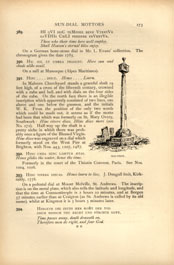
[Full Image]
MALVERN.
| 389. |
On a German hone-stone dial in Mr. L. Evans' collection. The chronogram gives the date 1785. |
| 390. | HIC SOL ET UMBRA PROSUNT. Here sun and shade alike avail. On a mill at Manosque (Alpes Maritimes). |
| 391. | HINC . . . . DISCE. Hence . . . . Learn. In Malvern Churchyard stands a graceful shaft 19 feet high, of a cross of the fifteenth century, crowned with a cube and ball, and with dials on the four sides of the cube. On the north face there is an illegible inscription which apparently consisted of two lines, one above and one below the gnomon, and the initials W. K. From the position of the only two words which could be made out, it seems as if the motto had been that which was formerly on St. Mary Overy, Southwark: Hinc vivere disce, Illinc disce mori (see No. 272). Half-way up the shaft is a pretty niche in which there was probably once a figure of the Blessed Virgin. Hinc disce was engraved on a dial which formerly stood on the West Pier at Brighton, with the Nos. 443, 1207, 1487. |
| 392. |
HINC UNDA HINC LABITUR ÆTAS. Formerly in the court of the Théatin Convent, Paris. See Nos. 1004, 1026. |
| 393. | HINC VIVERE DISCAS. Hence learn to live. J. Dougall fecit, Kirkcaldy. 1778. On a pedestal dial at Mount Melville, St. Andrews. The inscription is on the metal plate, which also tells the latitude and longitude, and that the time at Constantinople is 2 hours 10 minutes, and at Bergen 57 minutes earlier than at Craigton (as St. Andrews is called by its old name) whilst at Kingston it is 5 hours 5 minutes later. |
| 394. |
HINGETH DIE ZEITH HER KOMT DER TOD |
On the cross dial engraved in Johann Gaupp's "Tabulæ Gnomonicæ," 1708. See Nos. 230, 247. The lines are from a hymn written by Emilia Juliana, Countess of Schwarzburg-Rudolstadt, on the death of Duke Johann George of Sachsen-Eisenach in 1686. |
|
| 395. |
῾Ο ΗΛΙΟΣ ΠΑΝΤΑ ΜΕΡΕΙ On two of the faces of an octohedral dial of early seventeenth century French work in Mr. Evans' collection. See No. 295. It seems probable that the writer of this motto has made a mistake in using the word μέρει as if it were μεριζει. The word μέρει, as it stands, is the dative case of a noun : the tense seems to require a verb. |
| 396. |
῾Ο
ΚΑΙΡΟΣ
῾ΟΞϒΣ. Time is swift. On Alleyne's Grammar School, Uttoxeter. The dial was originally on the school-house built 1568, and was moved to the present building in 1859. The second motto is from Pindar, Olymp., i. 53. |
| 397. | HO LA VITA NELLA LUCE, LA MORTE NELLE TENEBRE. I have life in light, death in darkness. At Cossila, near Biella. |
| 398. | HOC AGE LUMEN ADEST. Be diligent, while the light abides, 1816. On a gable of the parish church at Chirnside, Berwickshire. The building has been restored, but part of it is Norman and the dial looks older than its date. Mr. Thomas Ross, who copied the motto in 1888, had difficulty in deciphering the word rendered lumen, but there is every reason to believe that the above reading is correct. A stone on the north gable is inscribed, "Repaired 1705," which may also be the original date of the dial. There are several old dials in the village of Chirnside, chiefly made by a man of the name of Dunbar. |
| 399. | HOC TUUM EST. This (hour) is thine own. On the south porch of Whitworth Church, Co. Durham. |
| 400. | HODIE MIHI, CRAS TIBI. To-day for me, to-morrow for thee. At Les Brévières, and at Mont Valezan, near Bellentre (both in Savoy). It is also on a silver folding-dial and calendar, of German workmanship, with a silver outer case like that of a watch, in Mr. L. Evans' collection. The opening lines of St. Bernard de Morlaix's hymn are also engraved on this dial, but the word sunt is omitted: Hora novissima, tempora pessima (sunt); vigilemus! |
| 401. |
HOMME MORTEL! LES HEURES DONT TU VOIS L'IMAGE On the École des Frères Maristes, at St. Pierre de Bressieux (Isère). |
| 402. | HOMME MORTEL SI TU ES FIN Mortal man, if thou art wise, behold, this dial marks thine end. As the style the shadow flies, so thy life perishes. On the church of St. Michel Chef (Loire Inférieure). Gilles Desclos was the curé of the parish. He is mentioned in an inscription inside the church which alludes to "M. Gilles Declos qui avec soin agissait." |
| 403. | HOMO FUGIT QUASI UMBRA. Man fleeth as a shadow. At Mont Valezan, near Bellentre, Savoy. |
| 404. | HOMO PROPONIT DEUS DISPONIT. Man proposes, God disposes. With No. 967 on the outside of the lid of a small ivory box and compass dial; or portarium, in the Musée Cluny, Paris. There are two mottoes inside the lid (Nos. 8 and 207), and the maker's name, "Hans Troschel, Noribergæ faciebat, Anno MDCXXVII." |
| 405. | HOMO QUASI UMBRA. Man is as a shadow. On the south wall of Cumwhitton Church, Cumberland. |
| 406. | HOMO QUASI FLOS CONTERITUR ET FUGIT VELUT UMBRA. Man is cut down like a flower, he fleeth also as a shadow. From Job. xiv. 2. In the Séminaire at Issy, near Paris. |
| 407. |
HOMO QUIDEM COGITAT, SED DEUS DISPONIT. These mottoes, with No. 1320, are on an ivory compass dial in the Victoria and Albert Museum, South Kensington, signed "Hans Troschel faciebat." |
| 408. | HOMO SAPIENS IN OMNIBUS METUET. He who is wise will fear at all times. At Alleins (Bouches de Rhône). |

[Full Image]
Sundial at Windsor Castle
Erected by KING CHARLES ye 2nd
bearing Motto
"HONI SOIT QUI MAL Y PENSE"
| 409. | HOMO VANITATI SIMILIS FACTUS EST: Man is like to vanity: his days are as a shadow that passeth away. Psalm cxliv. 4. On an old stone dial, bearing the arms of the family of Bourguignan, in the De Bresc collection. |
| 410. | HONI SOIT QUI MAL Y PENSE. Evil be to him who thinks evil thereof. Henricus Wynne. Londoninii, fecit. On a dial which Charles II. caused to be erected at Windsor, on the East Terrace, close to what are still known as "The Star Buildings."The plate is circular and horizontal, and in the centre the star of the Garter is engraved, with the motto upon it; the gnomon rises from this and is perforated, with the king's monogram and crown entwined therein. The pedestal is marble and decorated with carving in high relief, which is said to have been the work of Grinling Gibbons. |
| 411. | HONOR DOMINO PRO PACE POPVLO SVO PARTA. Honour be to the Lord for the peace procured for His people. Mentioned in Mr. Hilton's work on "Chronograms," as a motto on the upper border of a sun-dial formerly at the west end of Nantwich Church. It was removed in 1800. The date 1661 points to the year after the Restoration of Charles II. |
| 412. | HONOR SOLI DEO. Glory to God alone. At Déscines (Isère). |
| 413. | HORA AGENDI. It is the hour to act. At Malosa, near Voiron (Isère). |
| 414. | HORA BENE FACIENDI. It is the hour to do good. |
At Montferrat (Isère); on the church of St. Pierre de Paladru; and at Hyères. |
|
| 415. | HORA BIBENDI. The hour for drinking. With three other mottoes on a dial at Inch House, Midlothian, which was formerly at Craigmillar Castle (see No. 72). With No. 624 at Pont de Cervières (Hautes Alpes). At Le Pinet (Hautes Alpes), it is over the door of a house which was once a cabaret, and accompanies a picture of a wine pot and the words "Bon Vin." It has been seen in a similar position near Grenoble; and at Villard-Bonnot (Isère); and has also been read in the Crau, Provence, and, with the additional words, et solvendi ("and to take your ease"), in the department of Isère. A writer in the "Bulletin de la Société Astronomique de France," vii., 1860, speaking of the country about Abriès, near the Monte Viso, says: "Toutes les églises que nous avons vues dans notre excursions portaient sur leur clocher un cadran solaire, orné d'une devise latine, quelquefois assez singulièrement choisie – Nunc hora bibendi, par exemple." |
| 416. | HORA BREVIS AMICI LENTA ONEROSI. Péché, 8 Août 1847. Short is the time spent with a friend, long that spent with a bore. At Méaudre (Isère). |
| 417. | HORA, DIES, ET VITA FUGIUNT; MANET UNICA VIRTUS. The hour, day, and life, all fly away, virtue alone remains. On the column of a dial at St. George's Vicarage, Truro. |
| 418. | HORA EST IN QUA VERI ADORATES ADORABUNT. It is the hour in which true worshippers will worship. (from St. John, iv. 23). On a church in France belonging to the nuns of the Holy Sacrament, by whom Perpetual Adoration is maintained; also on a house at La Salle (Hautes Alpes). |
| 419. | HORA EST JAM NOS DE SOMNO SURGERE. Now it is high time to awake out of sleep (Rom. xiii. II). At Bellegarde; and on the Curé's house at Eyzin (Isère). Formerly on the Séminaire Magloire, Paris; and at Montmorency. |
| 420. | HORA EST ORANDI. It is the hour for prayer. At Maussane (Bouches du Rhône). |
| 421. |
HORA EST ULTIMA MULTIS For many 'tis their last hour. Watch thou, thine hour awaits thee when thou thinkest not. |
Formerly in the Collége de Navarre, which is now the Ecole Polytechnique, Paris. |
|
| 422. | HORA FLUIT, CULPÆ CRESCUNT, MORS IMMINET; Copied in 1866 from a dial on the church of St. Pierre, Canton, Valais. The motto was then somewhat defaced. The dial was painted on the south wall and protected by a buttress, and faced the snowy Mont Vélan. |
| 423. | HORA FUGIT. The hour flies. At Chapareillan, and Le Touront (Isère). Also at Bletchley Park, on a dial erected by H. S. Leon, Esq., in 1891. |
| 424. | HORA FUGIT, CELERI PROPERAT MORS IMPROBA PASSU. The hour flies, with swift step doth conquering death hasten on. Ieronimus Wulparia, Florentinus. A.D. MDLXXVII. See No. 801. On the back of a brass dial and astrolabe in the museum at Perugia. |
| 425. | HORA FUGIT; MEMENTO MORI. Time passes; remember death. On a dial which, until the recent restoration, was on the porch of the parish church of Rotherham. The motto replaced an older one, Pereunt et imputantur.
|
| 426. | HORA FUGIT: MORS VENIT. Time passes: death advances. 1703. Copied in 1888 from a dial painted on the wall of the old Court House at La Fiera de Primiero. There was a skull crowned by an hour glass in one corner, and a second motto, No. 1238, but both were somewhat defaced. |
| 427. | HORA FUGIT, NE TARDES. Time flies, delay thou not. Formerly in the Rue du Petit Musc, Paris. |
| 428. |
HORA FUGIT VOS PŒNITEAT SI TRANSIT INANIS In the garden of Notre Dame des Anges, formerly a convent of the Récollets, at Landecla, near Abervrach (Finistère). |
| 429. |
HORA HORIS CEDIT, PEREVNT SIC TEMPORA NOBIS: Many years ago the collector's (Mrs. Gatty's) old and kind friend, the late Lord Chief Justice Tindal, brought over for her from Karlsbad a mysterious inscription, which he had carefully copied in scholarly handwriting. The dial was formed on two sides of the angle of the upper storey of a substantial house in the market-place. The Chief Justice wrote, "The letters which are written in capitals were so in the original inscription, and were coloured red: probably the anagram of some one's name is concealed under them." By consulting that useful oracle, "Notes and Queries." we had the difficulty solved. We suggested that it might be a chronogram, but for the introduction of the letter E. A correspondent replied that probably CEdIt ought to be written CeDIt, when the following numerals could be extracted: MDCCVVVVIIIIIIIIII: MDCCXXX; 1730, which we may suppose to be the date of the building. It is amusing to record further, that some friends who were staying more recently at Karlsbad, kindly looked for this dial, which they found, but in a dilapidated state. They made out the motto, however, with the help of the Burgomaster of the place, who owned that he had lived opposite to it all his life, but had never noticed it. Nevertheless, he became much interested, and said he would give orders that it should be cleaned and repainted. The Doctor, too, confessed that he had never seen it before, but should henceforth point it out to his patients for their contemplation and improvement. |
| 430. |
HORA OMNIS TEMPUS SENEX TUA MUNERA LAUDANT This motto is difficult to interpret, but a learned scholar suggests that if laudant be read laudat, the meaning may be as follows: Father Time every hour praises thy bounteous gifts In the Jardin du Feuillant, Rue St. Honoré, Paris. |
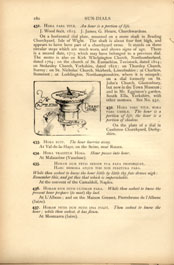
[Full Image]
AT CASTLETON DERBYSHIRE
Hora Pars Vitæ.
| 431. |
HORA PARS VITÆ.
An hour is a portion of life. On a horizontal dial plate, mounted on a stone shaft in Brading Churchyard, Isle of Wight. The shaft is about four feet high, and appears to have been part of a churchyard cross. It stands on three circular steps which are much worn, and shows signs of age. There is a second date, 1715, which may have belonged to a previous dial. The motto is also on Kirk Whelpington Church, Northumberland, dated 1764; on the church of St. Eustachius, Tavistock, dated 1814; on Stokesley Church, Yorkshire, dated 1822; on Thursley Church, Surrey; on St. Nicholas' Church, Skirbeck, Lincolnshire; at Charlton, Somerset; at Loddington, Northamptonshire, where it is misspelt; on a dial formerly on St. John's Church, Glastonbury, but now in the Town Museum; and in Mr. Egginton's garden, South Ella, Yorkshire, with other mottoes. See No. 932. |
| 432. | HORA PARS VITÆ, HORA PARS UMBRÆ. The hour is a portion of life, the hour is a portion of shadow. On the plate of a dial in Castleton Churchyard, Derbyshire. |
| 433. | HORA RUIT. The hour hurries away. At Val-de-la-Haye, on the Seine, near Rouen. |
| 434. | HORA TRADITUR HORA. Hour passes into hour. At Malaucène (Vaucluse). |
| 435. | HORAM DUM PETIS SENSIM TUA FATA PROPINQUAT,
While thou seekest to know the hour little by little thy fate draws nigh; At the convent of Camaldoli, Naples. |
| 436. | HORAM DUM PETIS ULTIMAM PARA. While thou seekest to know the present hour prepare (to meet) thy last. At L'Albenc; and on the Maison Gresset, Pierrebrune de l'Albenc (Isère). |
| 437. | HORAM PETIS DUM PETIS IPSA FUGIT. Thou seekest to know the hour; while thou seekest, it has flown. At Montcarra (Isère). |
